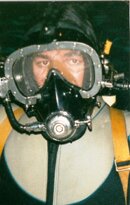As Environmental Officer of The Kwajalein Scuba Club, I'd me happy to address Matt's concerns. I'm a little disappointed that he didn't bring this directly to me.
1. Environment impact: How can a 1inch pin in the reef have more impact that a 3000lb concrete block. As you see in the above post, concrete blocks are no longer used, and can be bad for the environment. Think of the logistics of lowering a large block into the water, hooking a 4000lb lift bag (the size of a large waterbed) to it and towing it 5-10 miles away. Now do this 10 times. The other way would be to use an LCM and crane to load and up load, trying to place the block on target not damaging coral in the process. The crane and LCM are not available to the local dive community. This operation could only be done by commercial divers. Supporting the local recreation divers is not in their scope of work. Once again not available to support the local diving community.
2. Stability: Critical yes, impossible no. It is most important to drill into hard old coral. We have the same coral reef as Kosrae, and they have a very successful mooring program. I dove there in January of this year.
3. Safety: What makes you think, I have not had training in underwater drilling? One more incorrect assumptions.
4. Guidelines: There are many online, and we've look through all of them. The PADI Mooring Buoy Planning Guide, was submitted to the Army and RMI, as our primary guideline we will follow. Terry Hunt, in Hawaii, of the American Reef Coalition, has provided much information as well as hands on training. Terry and his volunteers have installed over 100 sites. They do great work in Hawaii, check out their website.
5. Not sure why you would state: "The governing authorities on the U.S. side more than likely hasn't been give all the the information to make an informed decision". This project has been in works for over two years. Every agency on Kwajalein has had input or chose not to. Including, the US Army, KRS, and the Real Property Board, as well as others. The biggest help has been USAKA Environmental office. Their office views this as a great effort to protect our natural resources.
6. $15,000: Keep in mind this is a start up effort. Please go online, start pricing out the equipment and material needed for installing 10 buoys. Start with a Hydraulic Power Unit, $5,000 to $6000.00, Stanley Hammer Drill Model HD45, 100ft of duel hydraulic hose, carbide drill bits, hose clamps, shackles, stainless steel pins. Then add in shipping to an island far far far away. Let me know what your total is.
7. Liability: Correct, the club insurance doesn't cover diving accidents, it is only liability. DAN also doesn't cover underwater drilling. That is what you have your company insurance for. I know, I've checked.
8. Sites to be moored: This was discussed at the August meeting, a map was available for those that attended. They are our most popular dive sites, included is Troy's Coral Head.
I will be happy to speak with anyone interested in this mooring project, or attend the monthly club meeting for updates.
Bill Williamson
PADI Staff Instructor
Kwajalein Scuba Club Environmental Officers




